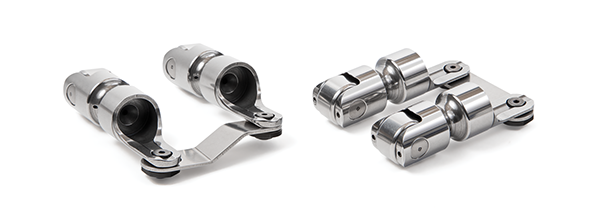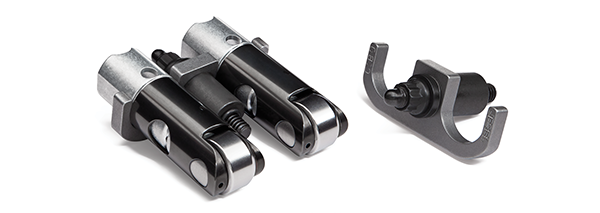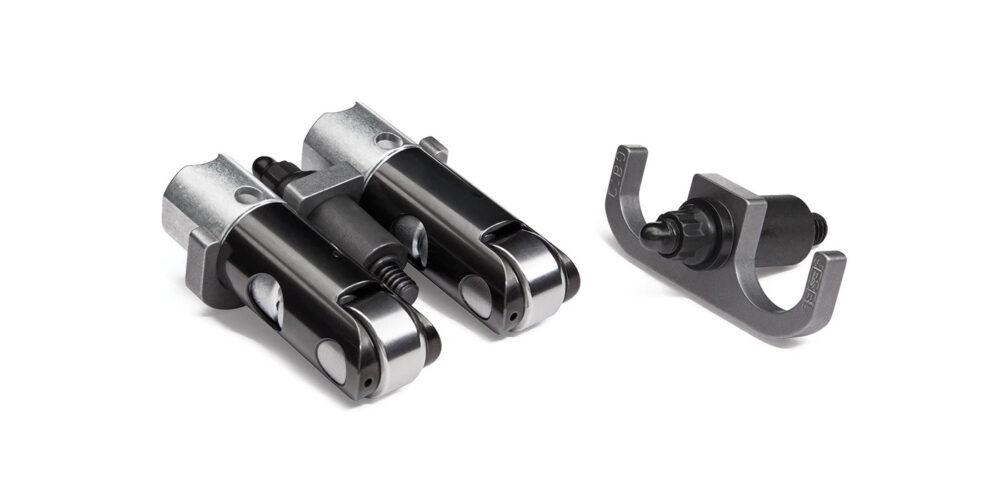When it comes to lifters, there will always be the traditional questions of solid versus hydraulic and flat tappet versus roller. Some of the answers may remain the same, but advancements in lifter and manufacturing technology, as well as modern testing and research is constantly evolving to make these components better. We took a look at today’s lifters, the technology behind them and some tips from the experts.
Hydraulic vs. Solid
Hydraulic lifters, or hydraulic lash adjusters (HLA) as they’re often called, eliminate noise by maintaining zero lash in the valvetrain. Compared to solid lifters, they’re easier on the valvetrain because they eliminate the hammering effect that occurs when the valves slam shut at higher engine speeds.
Hydraulic, by nature of their operation, also eliminates the regular lash adjustments which are required with solid lifters to compensate for wear, and they eliminate the related concerns of incorrect lash adjustment.
Too much lash reduces lift and duration, causing a loss in performance and a noisy valvetrain. Not enough does the opposite and causes the valves to open sooner and close later. This can result in reduced heat dissipation when the valves are closed, leading to a burned valve, or it can cause a loss of compression and contact with the piston. In addition, lash adjustments are often required to tune an engine for track conditions.

A downside to hydraulic lifters is that traditionally this style has limitations at higher rpm. If the valve springs aren’t strong enough, hydraulic lifters will “pump up” to take up the additional slack that isn’t actually there, but occurs when the valves don’t close quickly enough. This in turn holds the valves open and is referred to as valve “float.”
Quality is extremely important with hydraulic lifters. They are precisely machined assemblies of which the plunger is closely matched to the housing. Loose assembly tolerances will often “collapse” at high rpm by leaking too much pressure internally (poor leak-down rate). This problem is avoided by using a high-quality lifter, and this aspect of lifter production has improved considerably in recent years.
“The most significant advance has been the ability to more precisely manufacture HLA, allowing better targeting/control of the leak-down rates in mass production,” says Scott Stier, strategic marketing and technical coordinator, Elgin Industries. “This has also allowed HLA’s to be manufactured in smaller sizes.”
On modern engines with displacement-on-demand technology, deactivating the valves is a key part of making this technology effective. One method is to use lifters that can collapse on command and eliminate valve lift. These lifters are a dual feed design with two separate oil circuits.
“Dual oil circuits allow lash compensation as well as control of the HLA to deactivate the engine cylinder,” Stier says. “An oil control valve is used to lock and unlock the HLA. In deactivation mode, the lifter uses built-in lost motion to effectively absorb the cam motion rather than transfer it to the valve.”
Another problem that can occur with hydraulic-style lifters is collapsing of the lifter due to aerated oil. The higher the valve spring pressure, the more common the problem. The oil required to fill the lifter becomes aerated and the compression prevents the transfer of full lift.
For racing, a common trend to eliminate the problems associated with hydraulic lifters are the use of limited or short-travel hydraulic lifters. A reduction in plunger travel, which is usually about half that of a traditional full-travel lifter, reduces the amount of oil required to fill the lifter, which in turn reduces the compression of aerated oil.
Hydraulic lifters have become more popular with high performance and high-speed applications due to improved quality and manufacturing, as well as the advantages of limited travel hydraulic lifters. But, there will always be reasons to consider solid lifters.
In high-performance and racing engines, solid lifters often still have the advantage of handling higher speeds and maintaining more accurate valve timing and lift. Their precise valve control provides immediate response to the camshaft’s movement, and they can be better suited to engines that frequently rev to high rpm, with better valvetrain stability and reduced valve float.
Roller vs. Flat Tappet
On traditional flat tappet lifters, the base of the lifter may look flat, but it’s convex, with the center being about .001” to .002” higher than the edge. The lobes on a flat tappet cam are slightly tapered, and the centerline of the lifters are slightly offset in relation to the cam lobes. Add all this together and the lifters rotate as the cam turns, which helps reduce friction and wear.
The contact surface between the cam lobes and lifters is the highest loaded surface in an engine and the break-in process for a flat-tappet cam and lifters has always been very critical to promote the rotation of the lifters as they wear in with the cam and prevent immediate wear and damage to the camshaft.

The biggest aspect in which rollers differ from flat tappets is the lifter wheel must be held in fixed alignment with the cam, so it rolls smoothly on the lobe.
Flat tappets need good high-pressure lubrication in their high-load contact area. Take that away and it can spell trouble. Due to emission regulations, ZDDP additives have been removed from modern engine oil, and it’s the ZDDP, or zinc, that offered the high-pressure lubrication for a flat tappet. If you’re running a flat-tappet cam, you must use specific ZDDP motor oil or additives to prevent rapid wear.
This isn’t a problem on modern engines. In the ‘80s, roller lifters began to see regular use in production vehicles. As emission regulations got stricter and ZDDP was removed from engine oil, the lack of it had no affect on these engines due to the reduced friction of the roller.
With flat tappet lifters, you should always use a break-in oil with the correct ZDDP level designed for break-in, and it’s recommended to use a pre-blended oil. Too high a level of ZDDP can slow the break-in process and too much zinc can cause additional wear. Roller lifters don’t require ZDDP, which is a benefit of running them.
The idea of roller lifters is as old as the automotive industry itself, but it was racers who realized the benefits of a roller long before the OEMs made the switch for good. Roller lifters have an immediate advantage of reduced friction between the cam lobe and lifter, and also allow for cam profiles with faster opening and closing ramps. Not only are they original equipment on all of today’s pushrod engines, but they continue to be the preferred setup for racing, with a trend in street builds dropping their flat tappets for the advantages of roller.
The biggest aspect in which rollers differ from flat tappets is the lifter wheel must be held in fixed alignment with the cam, so it rolls smoothly on the lobe. There are multiple different ways to do this. One of the original methods utilized by the OEs was an alignment plate for each pair of lifters. Due to its shape, it was given the name “dog bone” to this style of roller lifter. One advantage with them is they are often lighter weight overall than other styles of roller lifters, and they’re an easy upgrade in many blocks originally designed for flat tappet.
When drilling is required, most companies offer a drill jig. In some cases, the alignment plate may need clearanced. The dog bone style of lifters, however, require a retainer for the alignment plates and have extended bodies to work with the alignment plates, which can interfere with pushrods where severe pushrod angles are required.
GM’s well-known LS series engines utilize plastic trays to keep the lifters in check, and many companies make performance lifters that work with them. However, many builders prefer to delete the trays and install tie bar lifters instead.
Tie bar lifters eliminate the need for a retention device and have proven successful in countless racing applications. The only job of the tie bar is to keep the lifter from turning, so they have a considerable amount of play in them to eliminate any resistance.
Keyway lifters are often considered the ultimate upgrade when it comes to rollers. These lifters have a special pin that aligns with a groove in the lifter bore, keeping the lifter aligned with the cam. These require the lifter bore to be machined and a special keyway bushing installed, but it eliminates the need for any additional type of alignment plate or retention device.

Dog Bone roller lifters get their name from the OE-style dog bone shape alignment plates that are bolted to the cylinder block for cam/roller alignment. Dog Bone roller lifters are lighter than traditional tie bar styles of lifters and can be easily installed using a Dog Bone Installation Fixture. These lifters are ideal for most forms of racing, available in lifter diameters of .842”, .875”, .905”, and .937”.
The most notable trends in roller lifters involve the wheel. Many companies offer a larger diameter wheel, which initially allows for a larger axle and bigger bearings that are stronger and more durable. A larger diameter roller also rotates slower, reducing the load needed to open a valve, and it can allow a more aggressive opening ramp design.
The traditional design for roller lifters incorporates needle bearings, which ride on the axle. The quality of these bearings is always improving, yet some consider it a drawback. If a wheel breaks, needle bearings can do extensive damage throughout the engine, and there’s a trend toward bushings to eliminate this possibility.
Quality roller lifters have an internal oil circuit that feeds pressurized oil to the bearings, and they feature a feed hole that sprays oil to the outer diameter of the wheel.
Lifter Bores
The lifter bore has often been overlooked in the past, but excessive wear in a flat tappet lifter bore can cause a lifter to wobble or stick and prevent rotation. When tolerances are out of specification, a loss of oil pressure can occur as well. Due to the fact that so many of the muscle car engines being rebuilt are quite simply old and often abused, it’s becoming a common practice for engine builders to check the lifter bores for roundness, straightness and alignment angle with the centerline of the camshaft.
To prevent wear to the lifter bore, a common trend in lifter design is locating the pushrod pivot point as low as possible in the lifter. The closer it is to the bottom, the less leverage there is to cause the body of the lifter to rock in the bore.
Oil Restrictors
Theoretically, with roller rockers and solid lifters, the valvetrain doesn’t need as much oil. Installing an oil restrictor limits the oil flow and reduces the windage from excess oil draining past the rotating assembly. It also keeps more oil flowing to the rod and main bearings. This is a specific application where some feel it improves performance.
The folks at Jesel point out that with the spring pressure and ratios being used in today’s racing engines, the lifters need as much oil to them as they can possibly get. They recommend plumbing the block, so oil is fed equally to the lifters through the front and rear of the oil galley, and in the event there is excessive oil to the top end, they recommend improving oil drain back to the pan through external scavenging lines or internal drains.
Restricting the oil flow to the lifters also limits oil flow to the cylinder heads. Since the oil cools the valve springs and other components, it’s not recommended to restrict oil flow.














